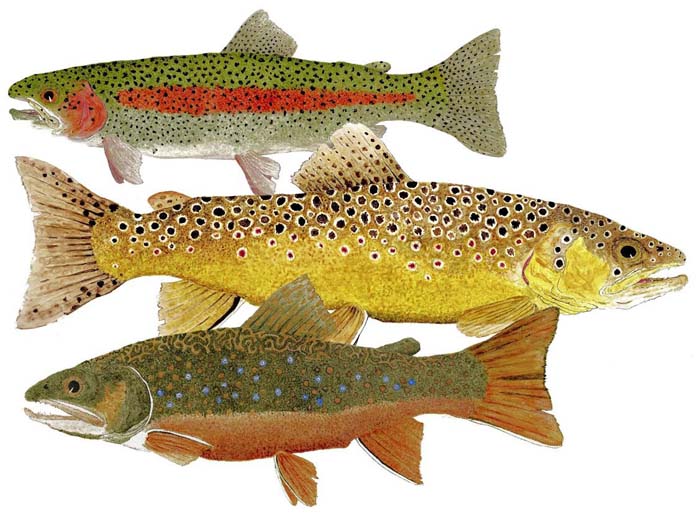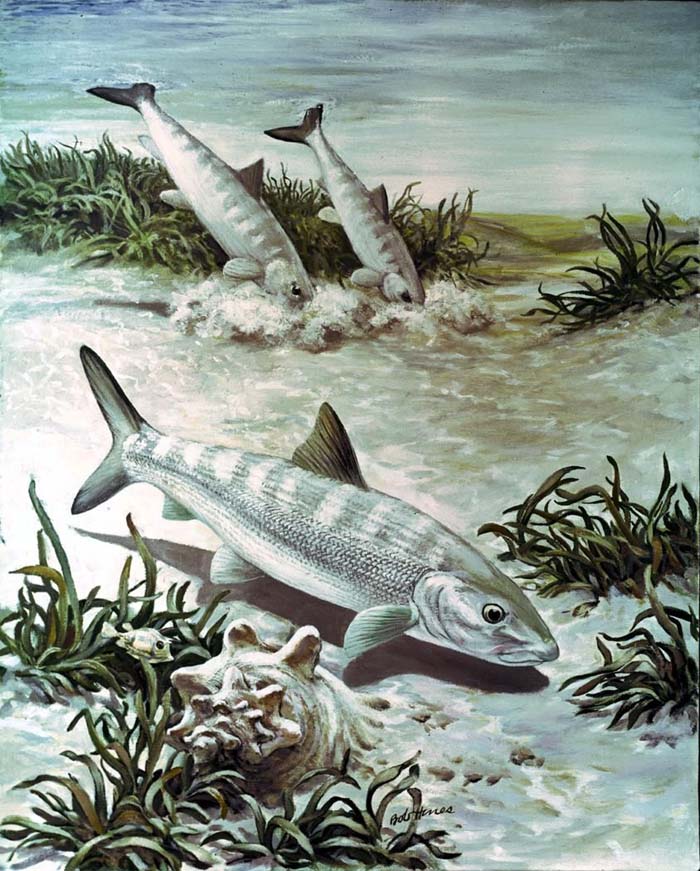
One of many Albies on a fly tied by Capt. Andrew Derr. The photo was taken by Derr while fishing a good client angler – Montauk, LI, New York on 9/18/19.
How does this percolate?
By Skip Clement, publisher emeritus
[dropcap]A[/dropcap]ccording to New Zealander, Neil Wagener, author of the article titled Are we training fish to avoid flies and lures? He says yes – his premise, and possibly yours, is that if “we” catch and release a few trout from a rich pool with a particular fly, pass the word around, and then come back a month or even a few weeks later, we can expect that the “killer” fly or any look-a-like pattern to most likely catch nada. The previously thought to be food, to the trout brains in that pool, henceforth decided that a particular “thing” is hazardous to the pool’s residents health, and should not get eaten.

The rainbow trout [Oncorhynchus mykiss], brown trout [Salmo trutta], and the iconic native North American brook trout [Salvelinus fontinalis]. Images provided courtesy of Thom Glace, award-winning watercolorist.
Bahamas
I have also and gotten advice from guides in the Bahamas about a particular bonefish fly no longer being as a good as it once was, or mostly, that another fly is better. So, does the regular appearance of a specific fly peril the chance of being successful if it’s go-to tied for saltwater animals like tarpon, snook, bonefish, or shark?
Salmon
Also, after trips to Iceland; Quebec and NL [Newfoundland and Labrador], Canada, and sage advice from ghillies there, all with decades of experience advising lords and baronets, gentlemen, crooks, and this scribe that the best flies to use catching Atlantic salmon, The King of Fish, remain to be patterns tied at the hands of “Fly Dressers” going back deep into the 17th century?
Science is hard to ignore
In the US largemouth bass fisheries this process is called “fish conditioning”, and there is a lot of discussion on the topic, with many pro bass fishermen confident that in heavily fished lakes the bass become conditioned to the most commonly used lures. Some of the best evidence for fish conditioning comes from the company behind Berkley Gulp! Pure Fishing. In lab experiments, researchers would expose groups of bass to a particular lure by casting it across the tank five times. Upon first seeing the lure all of the bass would hit it, with the number of strikes decreasing with each successive cast.
Essentially the bass weren’t getting the food they expected, so they became less interested. This process was then repeated on separate groups of bass with similar results. All of the bass were then left alone for three months before the same lure was again cast repetitively across the tank. This time each group of bass were uninterested in the lure, only striking at it a few times.
When a different type of lure was cast into the tank, however, the bass struck at it as often as they had when they first saw the original lure. This shows that not only were the bass able to remember that the lure wasn’t food for at least three months, they were also able to distinguish between similar lures. There is plenty of other evidence from fisheries around the world suggesting that fish can modify their behaviour in response to encounters with lures or hooks.”
—- Neil Wagener
Anyway, here’s the rest of what Mr. Wagener has to say . . .

Bonefish [Albula vulpes] mudding. Robert W. Hines, U.S. Fish and Wildlife Service. A commons image.

